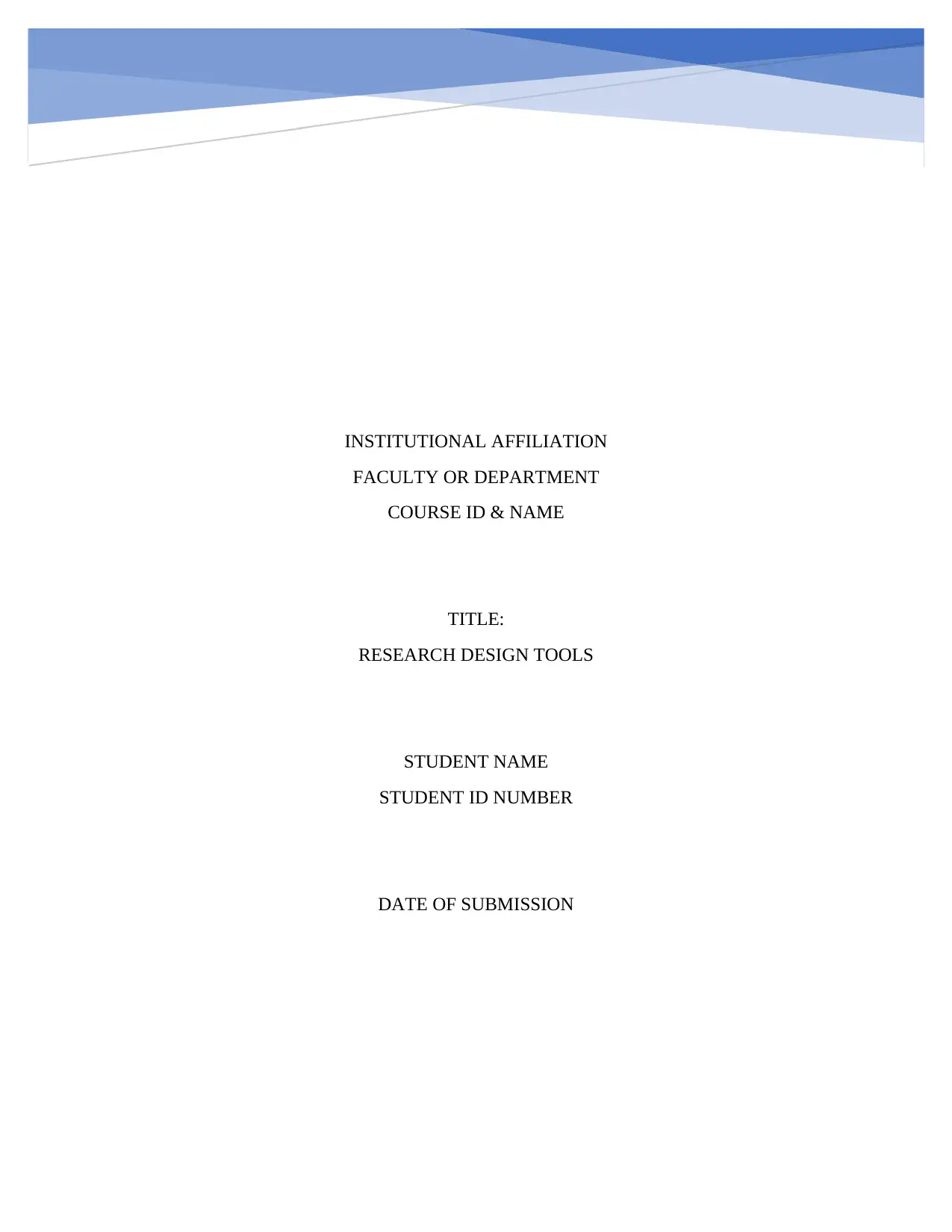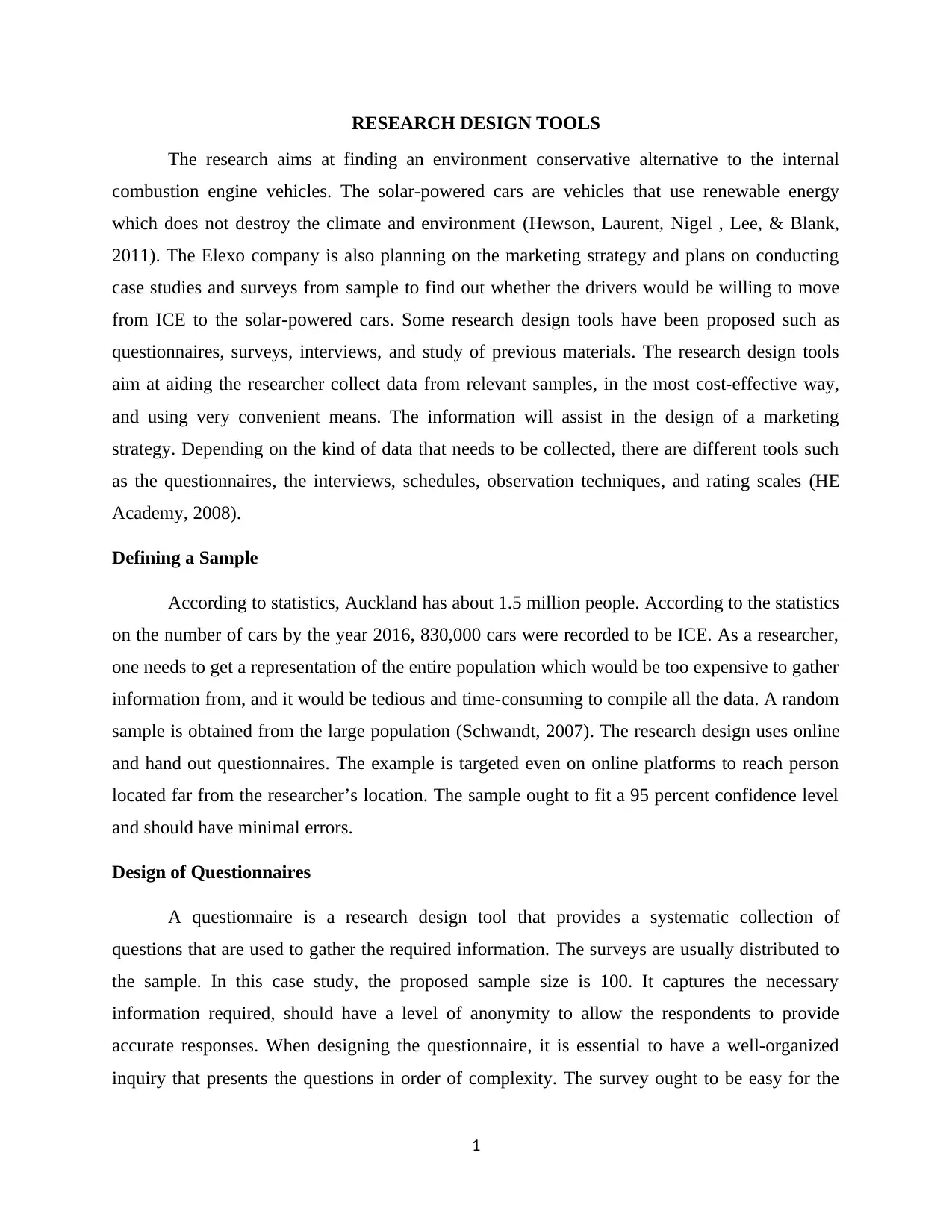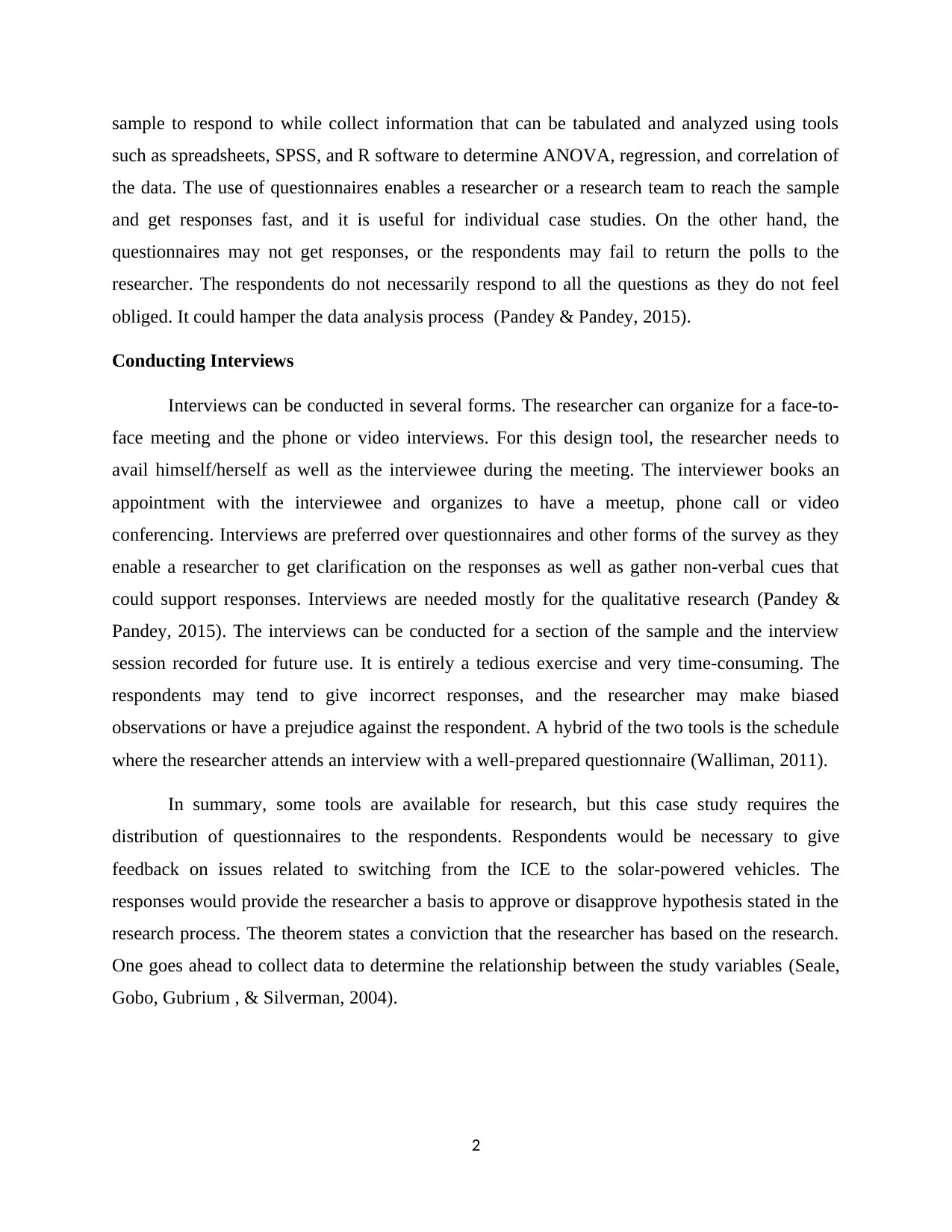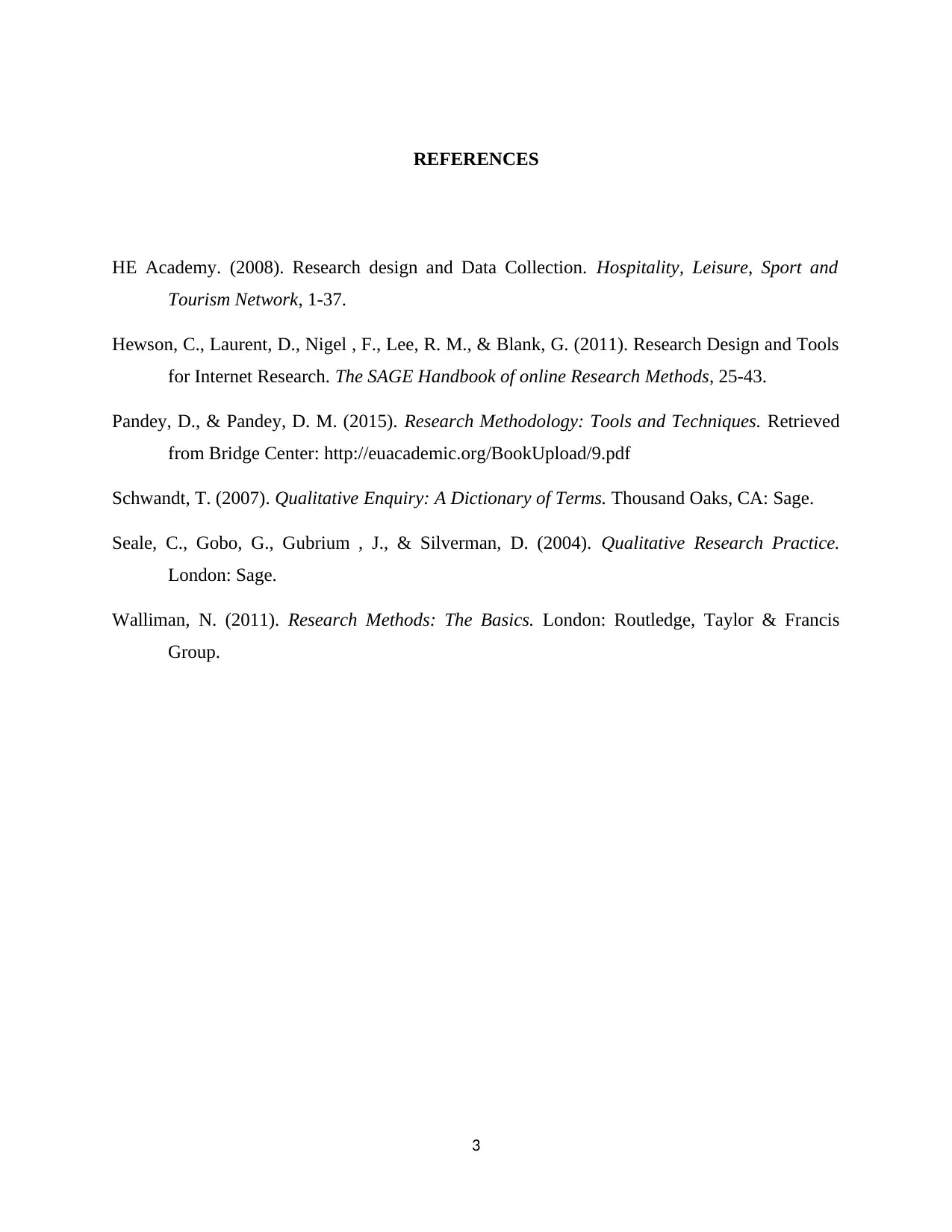Elexo Company: Research Design Tools for Solar Car Marketing Strategy
VerifiedAdded on 2023/06/11
|4
|1033
|203
Report
AI Summary
This report discusses research design tools applicable to developing a marketing strategy for solar-powered cars, specifically for the Elexo company. It highlights the use of questionnaires, surveys, and interviews to gather data on consumer willingness to switch from internal combustion engine (ICE) vehicles to solar-powered alternatives. The research emphasizes defining a representative sample from Auckland's population, designing effective questionnaires for online and offline distribution, and conducting informative interviews to gather both verbal and non-verbal cues. The report also acknowledges the limitations of each research tool and suggests a hybrid approach using schedules. Ultimately, the collected data aims to validate or disprove the researcher's hypothesis regarding the market viability of solar-powered vehicles, thereby informing a robust marketing strategy. Desklib provides access to this and other solved assignments for students.

INSTITUTIONAL AFFILIATION
FACULTY OR DEPARTMENT
COURSE ID & NAME
TITLE:
RESEARCH DESIGN TOOLS
STUDENT NAME
STUDENT ID NUMBER
DATE OF SUBMISSION
FACULTY OR DEPARTMENT
COURSE ID & NAME
TITLE:
RESEARCH DESIGN TOOLS
STUDENT NAME
STUDENT ID NUMBER
DATE OF SUBMISSION
Paraphrase This Document
Need a fresh take? Get an instant paraphrase of this document with our AI Paraphraser

RESEARCH DESIGN TOOLS
The research aims at finding an environment conservative alternative to the internal
combustion engine vehicles. The solar-powered cars are vehicles that use renewable energy
which does not destroy the climate and environment (Hewson, Laurent, Nigel , Lee, & Blank,
2011). The Elexo company is also planning on the marketing strategy and plans on conducting
case studies and surveys from sample to find out whether the drivers would be willing to move
from ICE to the solar-powered cars. Some research design tools have been proposed such as
questionnaires, surveys, interviews, and study of previous materials. The research design tools
aim at aiding the researcher collect data from relevant samples, in the most cost-effective way,
and using very convenient means. The information will assist in the design of a marketing
strategy. Depending on the kind of data that needs to be collected, there are different tools such
as the questionnaires, the interviews, schedules, observation techniques, and rating scales (HE
Academy, 2008).
Defining a Sample
According to statistics, Auckland has about 1.5 million people. According to the statistics
on the number of cars by the year 2016, 830,000 cars were recorded to be ICE. As a researcher,
one needs to get a representation of the entire population which would be too expensive to gather
information from, and it would be tedious and time-consuming to compile all the data. A random
sample is obtained from the large population (Schwandt, 2007). The research design uses online
and hand out questionnaires. The example is targeted even on online platforms to reach person
located far from the researcher’s location. The sample ought to fit a 95 percent confidence level
and should have minimal errors.
Design of Questionnaires
A questionnaire is a research design tool that provides a systematic collection of
questions that are used to gather the required information. The surveys are usually distributed to
the sample. In this case study, the proposed sample size is 100. It captures the necessary
information required, should have a level of anonymity to allow the respondents to provide
accurate responses. When designing the questionnaire, it is essential to have a well-organized
inquiry that presents the questions in order of complexity. The survey ought to be easy for the
1
The research aims at finding an environment conservative alternative to the internal
combustion engine vehicles. The solar-powered cars are vehicles that use renewable energy
which does not destroy the climate and environment (Hewson, Laurent, Nigel , Lee, & Blank,
2011). The Elexo company is also planning on the marketing strategy and plans on conducting
case studies and surveys from sample to find out whether the drivers would be willing to move
from ICE to the solar-powered cars. Some research design tools have been proposed such as
questionnaires, surveys, interviews, and study of previous materials. The research design tools
aim at aiding the researcher collect data from relevant samples, in the most cost-effective way,
and using very convenient means. The information will assist in the design of a marketing
strategy. Depending on the kind of data that needs to be collected, there are different tools such
as the questionnaires, the interviews, schedules, observation techniques, and rating scales (HE
Academy, 2008).
Defining a Sample
According to statistics, Auckland has about 1.5 million people. According to the statistics
on the number of cars by the year 2016, 830,000 cars were recorded to be ICE. As a researcher,
one needs to get a representation of the entire population which would be too expensive to gather
information from, and it would be tedious and time-consuming to compile all the data. A random
sample is obtained from the large population (Schwandt, 2007). The research design uses online
and hand out questionnaires. The example is targeted even on online platforms to reach person
located far from the researcher’s location. The sample ought to fit a 95 percent confidence level
and should have minimal errors.
Design of Questionnaires
A questionnaire is a research design tool that provides a systematic collection of
questions that are used to gather the required information. The surveys are usually distributed to
the sample. In this case study, the proposed sample size is 100. It captures the necessary
information required, should have a level of anonymity to allow the respondents to provide
accurate responses. When designing the questionnaire, it is essential to have a well-organized
inquiry that presents the questions in order of complexity. The survey ought to be easy for the
1

sample to respond to while collect information that can be tabulated and analyzed using tools
such as spreadsheets, SPSS, and R software to determine ANOVA, regression, and correlation of
the data. The use of questionnaires enables a researcher or a research team to reach the sample
and get responses fast, and it is useful for individual case studies. On the other hand, the
questionnaires may not get responses, or the respondents may fail to return the polls to the
researcher. The respondents do not necessarily respond to all the questions as they do not feel
obliged. It could hamper the data analysis process (Pandey & Pandey, 2015).
Conducting Interviews
Interviews can be conducted in several forms. The researcher can organize for a face-to-
face meeting and the phone or video interviews. For this design tool, the researcher needs to
avail himself/herself as well as the interviewee during the meeting. The interviewer books an
appointment with the interviewee and organizes to have a meetup, phone call or video
conferencing. Interviews are preferred over questionnaires and other forms of the survey as they
enable a researcher to get clarification on the responses as well as gather non-verbal cues that
could support responses. Interviews are needed mostly for the qualitative research (Pandey &
Pandey, 2015). The interviews can be conducted for a section of the sample and the interview
session recorded for future use. It is entirely a tedious exercise and very time-consuming. The
respondents may tend to give incorrect responses, and the researcher may make biased
observations or have a prejudice against the respondent. A hybrid of the two tools is the schedule
where the researcher attends an interview with a well-prepared questionnaire (Walliman, 2011).
In summary, some tools are available for research, but this case study requires the
distribution of questionnaires to the respondents. Respondents would be necessary to give
feedback on issues related to switching from the ICE to the solar-powered vehicles. The
responses would provide the researcher a basis to approve or disapprove hypothesis stated in the
research process. The theorem states a conviction that the researcher has based on the research.
One goes ahead to collect data to determine the relationship between the study variables (Seale,
Gobo, Gubrium , & Silverman, 2004).
2
such as spreadsheets, SPSS, and R software to determine ANOVA, regression, and correlation of
the data. The use of questionnaires enables a researcher or a research team to reach the sample
and get responses fast, and it is useful for individual case studies. On the other hand, the
questionnaires may not get responses, or the respondents may fail to return the polls to the
researcher. The respondents do not necessarily respond to all the questions as they do not feel
obliged. It could hamper the data analysis process (Pandey & Pandey, 2015).
Conducting Interviews
Interviews can be conducted in several forms. The researcher can organize for a face-to-
face meeting and the phone or video interviews. For this design tool, the researcher needs to
avail himself/herself as well as the interviewee during the meeting. The interviewer books an
appointment with the interviewee and organizes to have a meetup, phone call or video
conferencing. Interviews are preferred over questionnaires and other forms of the survey as they
enable a researcher to get clarification on the responses as well as gather non-verbal cues that
could support responses. Interviews are needed mostly for the qualitative research (Pandey &
Pandey, 2015). The interviews can be conducted for a section of the sample and the interview
session recorded for future use. It is entirely a tedious exercise and very time-consuming. The
respondents may tend to give incorrect responses, and the researcher may make biased
observations or have a prejudice against the respondent. A hybrid of the two tools is the schedule
where the researcher attends an interview with a well-prepared questionnaire (Walliman, 2011).
In summary, some tools are available for research, but this case study requires the
distribution of questionnaires to the respondents. Respondents would be necessary to give
feedback on issues related to switching from the ICE to the solar-powered vehicles. The
responses would provide the researcher a basis to approve or disapprove hypothesis stated in the
research process. The theorem states a conviction that the researcher has based on the research.
One goes ahead to collect data to determine the relationship between the study variables (Seale,
Gobo, Gubrium , & Silverman, 2004).
2
⊘ This is a preview!⊘
Do you want full access?
Subscribe today to unlock all pages.

Trusted by 1+ million students worldwide

REFERENCES
HE Academy. (2008). Research design and Data Collection. Hospitality, Leisure, Sport and
Tourism Network, 1-37.
Hewson, C., Laurent, D., Nigel , F., Lee, R. M., & Blank, G. (2011). Research Design and Tools
for Internet Research. The SAGE Handbook of online Research Methods, 25-43.
Pandey, D., & Pandey, D. M. (2015). Research Methodology: Tools and Techniques. Retrieved
from Bridge Center: http://euacademic.org/BookUpload/9.pdf
Schwandt, T. (2007). Qualitative Enquiry: A Dictionary of Terms. Thousand Oaks, CA: Sage.
Seale, C., Gobo, G., Gubrium , J., & Silverman, D. (2004). Qualitative Research Practice.
London: Sage.
Walliman, N. (2011). Research Methods: The Basics. London: Routledge, Taylor & Francis
Group.
3
HE Academy. (2008). Research design and Data Collection. Hospitality, Leisure, Sport and
Tourism Network, 1-37.
Hewson, C., Laurent, D., Nigel , F., Lee, R. M., & Blank, G. (2011). Research Design and Tools
for Internet Research. The SAGE Handbook of online Research Methods, 25-43.
Pandey, D., & Pandey, D. M. (2015). Research Methodology: Tools and Techniques. Retrieved
from Bridge Center: http://euacademic.org/BookUpload/9.pdf
Schwandt, T. (2007). Qualitative Enquiry: A Dictionary of Terms. Thousand Oaks, CA: Sage.
Seale, C., Gobo, G., Gubrium , J., & Silverman, D. (2004). Qualitative Research Practice.
London: Sage.
Walliman, N. (2011). Research Methods: The Basics. London: Routledge, Taylor & Francis
Group.
3
1 out of 4
Related Documents
Your All-in-One AI-Powered Toolkit for Academic Success.
+13062052269
info@desklib.com
Available 24*7 on WhatsApp / Email
![[object Object]](/_next/static/media/star-bottom.7253800d.svg)
Unlock your academic potential
Copyright © 2020–2025 A2Z Services. All Rights Reserved. Developed and managed by ZUCOL.




